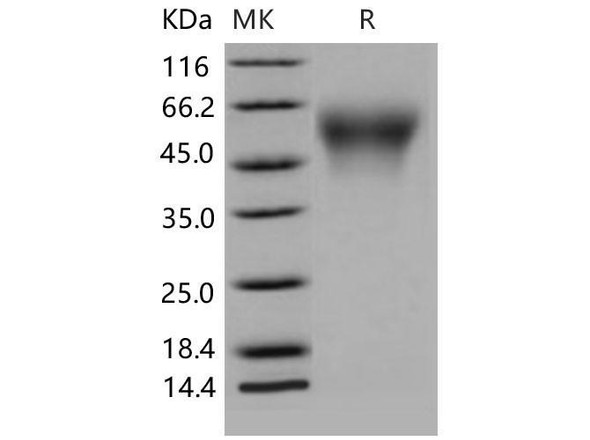Description
| Product Name: | Mouse PEBP1 Recombinant Protein |
| Product Code: | RPPB4222 |
| Size: | 20µg |
| Species: | Mouse |
| Target: | PEBP1 |
| Synonyms: | Phosphatidylethanolamine-binding protein 1, PEBP-1, HCNPpp. |
| Source: | Escherichia Coli |
| Physical Appearance: | Sterile Filtered colorless solution. |
| Formulation: | PEBP1 protein solution (1mg/ml) containing PhosphateBuffered Saline (pH7.4) and 10% glycerol. |
| Stability: | Store at 4°C if entire vial will be used within 2-4 weeks. Store, frozen at -20°C for longer periods of time. For long term storage it is recommended to add a carrier protein (0.1% HSA or BSA).Avoid multiple freeze-thaw cycles. |
| Purity: | Greater than 95.0% as determined by SDS-PAGE. |
| Amino Acid Sequence: | MGSSHHHHHH SSGLVPRGSH MGSMAADISQ WAGPLCLQEV DEPPQHALRV DYAGVTVDEL GKVLTPTQVMNRPSSISWDG LDPGKLYTLV LTDPDAPSRK DPKFREWHHF LVVNMKGNDI SSGTVLSDYV GSGPPSGTGLHRYVWLVYEQ EQPLSCDEPI LSNKSGDNRG KFKVETFRKKYNLGAPVAGT CYQAEWDDYV PKLYEQLSGK |
PEBP1 (Phosphatidylethanolamine binding protein 1) belongs to the phosphatidylethanolamine-binding protein family and a serine protease inhibitor that inhibits thrombin, neuropsin. PEBP1 plays a key modulatory part in several protein kinase signaling cascades. PKC phosphorylates PEBP1, resulting in the release of Raf-1 and activation of MEK and ERK. PEBP1 is expressed in many tissues and implicated in the regulation of such physiological processes as membrane biosynthesis, spermatogenesis, neural development, and metastasis suppression.PEBP1 binds ATP, opioids and phosphatidylethanolamine, however it has lower affinity for phosphatidylinositol and phosphatidylcholine. PEBP1 may also be involved in the function of the presynaptic cholinergic neurons of the CNS. PEBP1 increases the production of choline acetyltransferase although not acetylcholinesterase. Furtheremore, PEBP1 functions in potentially sequestering toxic compounds, including locostatin which may have harmful effects on cells.Loss of PEBP1 expression may have a significant role as prognostic marker in Gastrointestinal stromal tumors. In addition, PEBP1 is found differentially expressed in the Wernicke's Area from schizophrenia patients. PEBP1 is also, an invasion suppressor protein in nasopharyngeal carcinoma.
PEBP1 Mouse Recombinant produced in E.Coli is a single,non-glycosylated polypeptide chain containing 210 amino acids (1-187 a.a) andhaving a molecular mass of 23.2kDa.PEBP1 is fused to a 23 amino acid His-tag at N-terminus& purified by proprietary chromatographic techniques.
| UniProt Protein Function: | RKIP: a metastasis suppressor that regulates extracellular matrix remodeling and tumor survival. Binds to and inhibits Raf-1. Phosphorylation by classic and atypical but not novel PKC isoforms dissociates this complex, relieving inhibition of the Raf/MAP kinase signaling cascade. Binds ATP, opioids and phosphatidylethanolamine. Has lower affinity for phosphatidylinositol and phosphatidylcholine. Serine protease inhibitor which inhibits thrombin, neuropsin and chymotrypsin but not trypsin, tissue type plasminogen activator and elastase Inhibits the kinase activity of RAF1 by inhibiting its activation and by dissociating the RAF1/MEK complex and acting as a competitive inhibitor of MEK phosphorylation. Cleaved into hippocampal cholinergic neurostimulating peptide (HCMP) that appears to be involved in the function of the presynaptic cholinergic neurons of the central nervous system. HCNP increases the production of choline acetyltransferase but not acetylcholinesterase. Expressed in brain. Increased expression in aged senescence-accelerated mice.Protein type: Protein kinase, regulatory subunit; Lipid-bindingCellular Component: Golgi apparatus; extracellular space; neuron projection; cell surface; rough endoplasmic reticulum; mitochondrion; mitochondrial outer membrane; synaptic vesicle; cell soma; apical part of cell; cytoplasm; nerve terminal; nucleus; myelin sheathMolecular Function: serine-type endopeptidase inhibitor activity; enzyme binding; protease inhibitor activity; nucleotide binding; mitogen-activated protein kinase binding; lipid binding; kinase binding; protein kinase binding; ATP binding; receptor bindingBiological Process: positive regulation of mitosis; negative regulation of protein amino acid phosphorylation; negative regulation of MAPKKK cascade; regulation of neurotransmitter levels; MAPKKK cascade; negative regulation of peptidase activity; regulation of the force of heart contraction; sperm capacitation |
| UniProt Protein Details: | |
| NCBI Summary: | |
| UniProt Code: | P70296 |
| NCBI GenInfo Identifier: | 29840839 |
| NCBI Gene ID: | 23980 |
| NCBI Accession: | P70296.3 |
| UniProt Secondary Accession: | P70296,Q9D8G9, Q9JJ58 |
| UniProt Related Accession: | P70296 |
| Molecular Weight: | 20,830 Da |
| NCBI Full Name: | Phosphatidylethanolamine-binding protein 1 |
| NCBI Synonym Full Names: | phosphatidylethanolamine binding protein 1 |
| NCBI Official Symbol: | Pebp1�� |
| NCBI Official Synonym Symbols: | Pbp; HCNP; Pbp1; Pbpr; Rkip�� |
| NCBI Protein Information: | phosphatidylethanolamine-binding protein 1; HCNPpp; PEBP-1; Raf-1 inhibitor protein; Raf-1 kinase inhibitor protein |
| UniProt Protein Name: | Phosphatidylethanolamine-binding protein 1 |
| UniProt Synonym Protein Names: | HCNPppCleaved into the following chain:Hippocampal cholinergic neurostimulating peptide; HCNP |
| Protein Family: | Phosphatidylethanolamine-binding protein |
| UniProt Gene Name: | Pebp1�� |
| UniProt Entry Name: | PEBP1_MOUSE |









